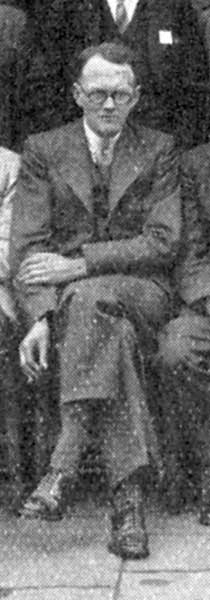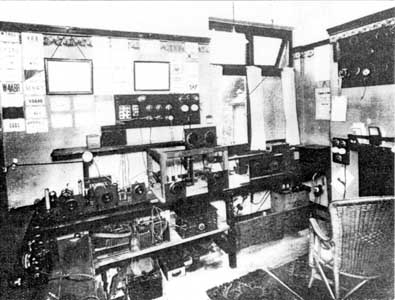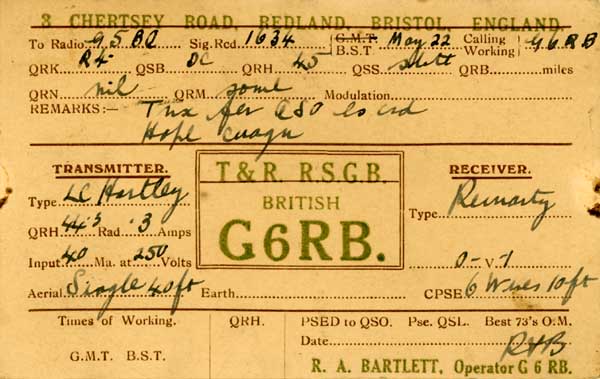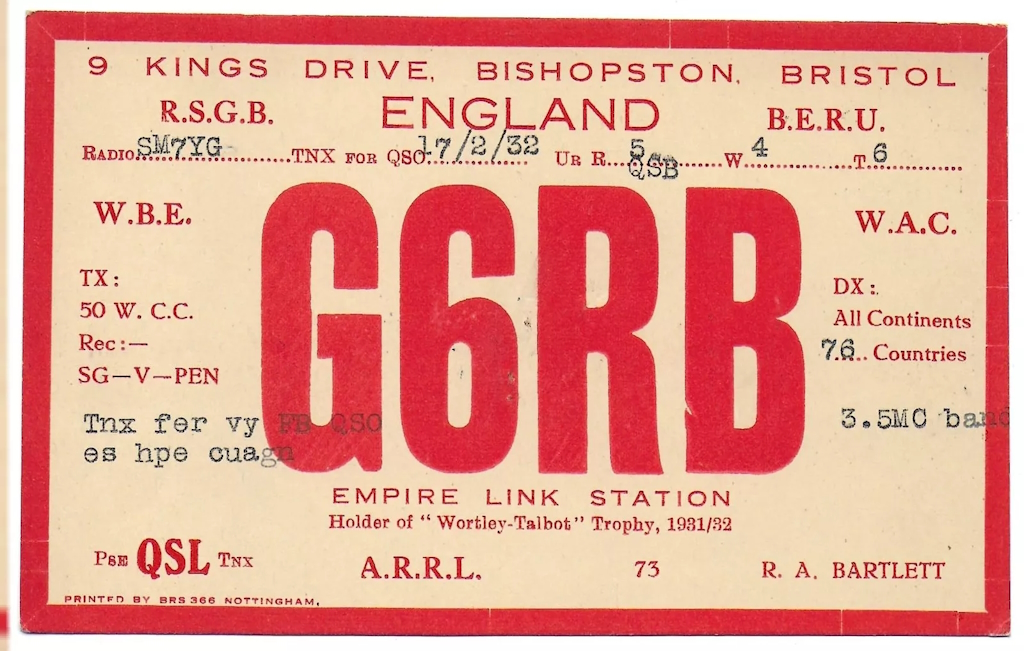

Arthur Bartlett G6RB was the backbone of the RSGB Bristol Group’s pre-war entries in NFD. He was equal first “A” station in the first NFD and ran the “A” station again in the winning 1934 team. He won the 1938 7 Mc/s shield. He also took part in some of the post-war entries, his call being used in the 1949 and 1950 entries, he appears in the 1955 NFD Photograph.
The card above from 1927, shows the transmitter power as 10 watts DC in, and the frequency used is in the 45 metre band around 6.6 Mc/s, an amateur allocation then, but now the haunt of pirates and long range ASR communications.
The article below is taken from The T&R Bulletin for September, 1931.
STATION DESCRIPTION No. 16.
G6RB.
By “QRQ.”
We have pleasure in presenting herewith a description of Station G6RB, winner of the “Wortley-Talbot Trophy” for 1931-32. To Mr. Bartlett, the operator and owner, we offer sincere congratulations.
MR. R. A. BARTLETT, of G6KB, needs no introduction, as his signals are well known to amateurs in practically every country of the world, and his call-sign appears in nearly every published list of “Calls Heard G6RB started radio work many years ago as a sea-going commercial operator, and he is the possessor of a first-class P.M.G. operator’s certificate After a year or so as a BRS station, during which time he co-operated with many DX stations by reports on their tests and schedules, he obtained his transmitting licence in April of 1927.
At this time the station was in.Redland, Bristol, and it was in a most unfavourable position for transmission, being situated in a valley and badly screened by houses. The transmitter was a low-power T.P.T.G., using an LS5 valve as oscillator, feeding into a loose-coupled aerial and counterpoise. In spite of the handicap under which the station was placed, excellent work was done with low power, and later, when a 50-watt licence was granted to G6RB, he substituted a DETI for the old LS5, and soon won his W.A.C. certificate.
Near the. end of 1928, however, the station was moved to its present situation at Bishopston, a suburb lying near the outskirts of Bristol. The site of the station is now at the top of a hill, and as there is but little local screening, the position is much better for radio transmission than the old site at Redland. It is in this QRA that his best work has been performed.
The photo shows a general view of the ” radio shack ” – a room situated on the first floor of the house, devoted entirely to radio. The transmitter is crystal-controlled in the 3.5, 7 and 14 M.C. bands, using the Goyder blocked oscillating amplifier method. The crystal oscillator, followed by two frequency doublers, is on the bench on the left. The frequency doubler anode coil is magnetically coupled to the grid coil of the power amplifier, thus locking the P.A. frequency to that of the doubler. The P.A., on the bench next to the crystal stages, consists of the usual T.P.T.G. circuit employing a DET1SW valve. Situated above the P.A. can be seen the feeder tuning panel and the main power switchboard.

Under the bench the speech amplifier for telephony transmission is visible. Grid modulation is employed, the output of the amplifier being fed into the grid leak circuit of the P.A., through a transformer. An Adolph microphone is used.
The main power supply for the P.A. is derived from a full-wave chemical rectifier of the ” bridge ” type, using lead and aluminium electrodes in a borax solution This rectifier is supplied from the large power transformer seen under the right-hand end of the bench The output from the rectifier is smoothed with the usual choke and condensers Only a small smoothing filter is required with the chemical rectifier, and an output of pure D.C. at about 850 volts is obtained.
The power supply for the crystal stages is also underneath the bench ; this consists of a full-wave valve rectifier giving an output of 250 volts at 60 mA The speech amplifier is fed from this same source, when telephony is used. The filament supply on all valves in the transmitter is A.C., derived from a 6-volt transformer.
The short-wave receiver, on the right of the transmitter. consists of a detector followed by one stage of L.F. amplification A screened grid valve is used as detector. with excellent results, in spite of the fact that the L.F. amplifier is transformer-coupled Shortly however, the choke-resistance amplifier is to be tested, and it is expected that this will give better results. Hand and body capacity effects are overcome by extension spindles on the condensers, and by HF chokes in the phone leads.
The monitor at the right-hand end of the bench is used for checking transmissions and for locking the P.A. A switch changes over the phones from receiver to monitor and vice versa.
Three crystals are available for the control of the transmitter, so that changes may be made to avoid interference. On the 3.5 M.C. band the transmitter is sometimes worked as a self-excited oscillator, as on this band the note is good without crystal stabilisation.
Many aerials have been used, and all the well-known types have been tested by G6RB ; the best aerial for general DX work appears to be his present aerial, which is a Zeppelin, full-wave on 14 M.C. Half-wave feeders are employed, and with 40 watts input the feeder current on 14 M.C. is about 0.8 amp. The aerial is only just over 30 feet high and is used for all three bands. On the 3.5 M.C. one side of this aerial, together with a counterpoise, is used with excellent results.
Regarding DX contacts, about 74 countries have been worked at present, and the W.A.C. and W.B.E. certificates have been on the wall of the station for a considerable time. The most outstanding work was the two-way contact between G6RB and ZL2BK last winter on the 3.5 M.C. band. The input to the P.A. on this occasion was only 22 watts.
No work has been done on 28 M.C. so far, but a transmitter for this frequency will be built for use in the coming season, especially if conditions show signs of improving.
G6RB is a very keen member of the R.S.G.B., and he takes a great interest in the 3.5 M.C. band. On this band he has organised the Contact Bureau Group. It is in recognition of his work on this band that the Wortley-Talbot Trophy has been awarded to him this year.
In concluding, G6RB is always delighted to see any amateurs who may care to visit his station, and visitors are assured of a warm welcome. The writer feels confident that all stations will join with him in offering hearty congratulations to G6RB.

